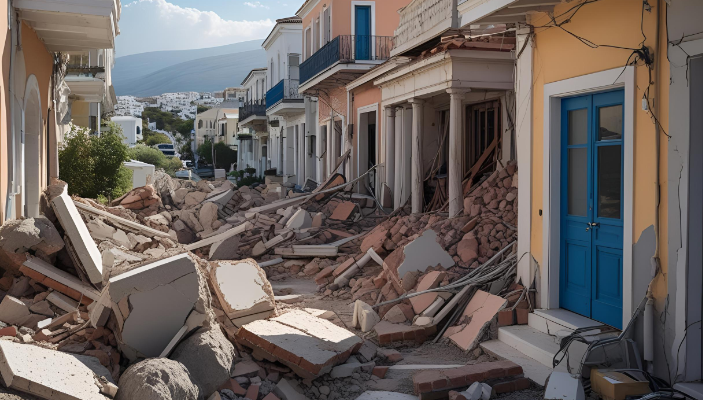Greece is one of the most seismically active countries in Europe. Situated on the complex boundary between the African and Eurasian tectonic plates, it experiences frequent earthquakes, ranging from mild tremors to destructive events. Understanding the nature of earthquakes in Greece is essential not only for residents but also for tourists, architects, urban planners, and policymakers. This article presents a well-rounded, informative view on why earthquakes occur in Greece, what areas are most at risk, how the country responds, and what safety measures are in place.
Why Earthquakes Are Frequent in Greece
Tectonic Location and Geological Structure
Greece lies in a seismically sensitive zone due to the ongoing collision of the African plate with the Eurasian plate. This interaction generates significant stress along faults beneath the Aegean Sea and the Hellenic Arc, leading to ground shaking.
Key geological factors include:
-
Subduction Zones: The Hellenic Subduction Zone is responsible for many of the strongest quakes.
-
Fault Lines: Numerous active faults cross mainland Greece and the surrounding islands.
-
Crustal Deformation: The constant pressure and movement reshape the landscape, contributing to recurring seismic events.
Aegean Microplate Movement
The Aegean Sea Plate is an independent tectonic microplate between the African and Eurasian plates. It moves in a complex pattern, influenced by both subduction and extensional tectonics, making central and southern Greece hotspots for seismic activity.
Regions with the Highest Seismic Risk
Ionian Islands and Western Greece
This region experiences some of the most frequent and intense seismic activity in the country. Cities like Zakynthos, Kefalonia, and Patras are particularly vulnerable.
Crete and the Southern Aegean
Crete and nearby islands sit above the Hellenic Subduction Zone, where large-magnitude earthquakes have occurred historically and remain a concern.
Athens and Central Mainland
While not the most active area, central Greece, including Athens, has experienced deadly quakes, such as the 1999 event that killed over 140 people. Proximity to fault systems like the North Anatolian Fault increases risk.
Historical Earthquakes in Greece
Greece has a long seismic history dating back to antiquity, with several major events shaping both infrastructure and culture. Some key examples:
-
365 AD Crete Earthquake: Estimated at magnitude 8.0+, followed by a massive tsunami.
-
1953 Ionian Earthquake: A series of quakes up to magnitude 7.2 that devastated Kefalonia and Zakynthos.
-
1999 Athens Earthquake: Magnitude 6.0, caused widespread damage and over 140 deaths.
-
2020 Samos Earthquake: Magnitude 7.0 quake in the Aegean Sea affected Greece and Turkey, resulting in casualties and building collapses.
Greece’s Earthquake Preparedness and Building Resilience
Seismic Building Codes
After devastating quakes in the mid-20th century, Greece introduced strict seismic codes. Today, most new buildings are designed to withstand significant shaking. Key features include:
-
Reinforced Concrete Frames
-
Flexible Foundation Design
-
Retrofitting of Older Structures
Public Awareness and Drills
Earthquake preparedness is embedded in Greek education and public policy. Schools, offices, and emergency services regularly conduct drills to ensure quick response and minimize panic.
Educational outreach includes:
-
Instructional guides for homes and schools
-
Simulated earthquake training
-
Emergency kits and evacuation maps
Role of Earthquake Planning Organizations
The Institute of Geodynamics in Athens and the Earthquake Planning and Protection Organization (EPPO) monitor seismic data and issue public alerts. These institutions coordinate closely with civil defense to provide real-time updates and safety instructions.
Earthquake Forecasting and Limitations
While exact prediction of earthquakes remains scientifically elusive, Greece has invested in advanced monitoring technologies such as:
-
Seismographic Networks: Monitor ground motion and detect tremors early.
-
GPS and Satellite Data: Track crustal deformation patterns.
-
Risk Modeling: Helps identify regions with the highest structural vulnerabilities.
Despite these tools, the precise timing and location of future earthquakes cannot be forecasted. The focus remains on risk reduction, not prediction.
Impact on Society, Economy, and Culture
Earthquakes in Greece have far-reaching effects beyond physical destruction:
-
Tourism: Major tremors can disrupt travel, although the industry generally recovers quickly.
-
Cultural Heritage Sites: Many ancient ruins are susceptible to damage. Conservation efforts are prioritized post-quake.
-
Insurance and Real Estate: Earthquake-prone zones often see fluctuating property values and rising insurance premiums.
Travel and Earthquake Safety Tips
Greece remains a safe and welcoming destination for travelers. However, being informed and prepared helps:
-
Know the Emergency Numbers: 112 is the EU-wide emergency number.
-
Stay in Earthquake-Resilient Structures: Modern hotels typically meet seismic codes.
-
Pack Basic Emergency Items: Flashlight, water, copies of ID, and local contacts.
-
Follow Local Instructions: Listen to authorities and act quickly if tremors begin.
Conclusion
Greece’s location on the frontlines of European seismic activity makes earthquakes a regular part of life. However, the country has made impressive strides in resilience—through building safety, public education, and continuous monitoring. While earthquakes can’t be prevented, their impact can be managed through awareness, preparedness, and structural planning.
If you live in or plan to visit Greece, understanding the country’s seismic nature is not about fear—it’s about staying informed and safe in one of the most beautiful, historic, and geologically fascinating regions in the world.




